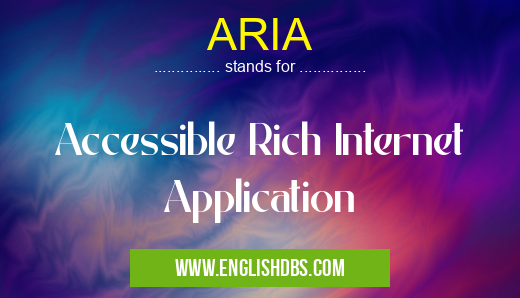What does ARIA mean in INTERNET
ARIA (Accessible Rich Internet Applications) is a set of web accessibility guidelines developed by the World Wide Web Consortium (W3C). It provides a way to make web content and applications more accessible to people with disabilities, such as those with visual, auditory, cognitive, or motor impairments.

ARIA meaning in Internet in Internet
ARIA mostly used in an acronym Internet in Category Internet that means Accessible Rich Internet Application
Shorthand: ARIA,
Full Form: Accessible Rich Internet Application
For more information of "Accessible Rich Internet Application", see the section below.
What is ARIA?
ARIA is a set of attributes that can be added to HTML elements to provide additional information about their role and behavior. This information can then be used by assistive technologies, such as screen readers, to provide a more accessible experience for users.
Benefits of Using ARIA
Using ARIA can provide a number of benefits for people with disabilities, including:
- Improved navigation: ARIA can help users navigate web content more easily by providing information about the structure and layout of the page.
- Enhanced interaction: ARIA can make it easier for users to interact with web content by providing information about the purpose and behavior of controls.
- Increased accessibility: ARIA can help to ensure that web content is accessible to a wider range of users, including those with disabilities.
How to Use ARIA
To use ARIA, you can add attributes to HTML elements that provide information about their role, state, and properties. For example, you could add the role attribute to an element to indicate its role in the page, such as a "navigation" or "main" role.
Essential Questions and Answers on Accessible Rich Internet Application in "INTERNET»INTERNET"
What is ARIA?
ARIA (Accessible Rich Internet Application) is a technical specification that defines a set of attributes, roles, and states that web developers can use to make their web pages and applications more accessible to users with disabilities. These attributes, roles, and states provide additional information to assistive technologies, such as screen readers, to help users understand the structure and functionality of the page or application.
Why is ARIA important?
ARIA is important because it enables web developers to create more accessible web experiences for users with disabilities. By providing additional information to assistive technologies, ARIA helps users to navigate and interact with web pages and applications more easily. This can make a significant difference for users who rely on assistive technologies to access the web.
How do I use ARIA?
To use ARIA, you need to add ARIA attributes, roles, and states to the HTML code of your web page or application. The specific attributes, roles, and states that you use will depend on the content and functionality of your page or application. You can find more information about how to use ARIA on the W3C website.
What are some of the benefits of using ARIA?
Using ARIA can provide a number of benefits, including:
- Improved accessibility for users with disabilities
- Increased user satisfaction
- Better search engine optimization (SEO)
- More efficient development process
What are some of the challenges of using ARIA?
There are a few challenges that you may encounter when using ARIA, including:
- The need to learn a new set of attributes, roles, and states
- The potential for conflicts with other ARIA implementations
- The need to test your pages or applications thoroughly to ensure accessibility
Final Words: ARIA is an important tool for improving the accessibility of web content and applications. By using ARIA, you can make your content more accessible to a wider range of users, including those with disabilities.
